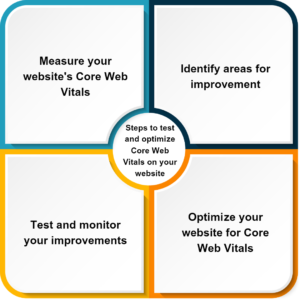Website performance is crucial for delivering a seamless user experience. Core Web Vitals have become a key metric for measuring and optimizing website performance. In this blog post, we will explore the importance of Core Web Vitals and provide you with a comprehensive guide on how to test and improve them on your website.
Understanding Core Web Vitals:
Core Web Vitals are a set of specific website performance metrics introduced by Google. They focus on three key aspects of user experience: loading, interactivity, and visual stability. These metrics are measured based on real user data and are considered essential for a website’s overall performance and search engine rankings.
The three Core Web Vitals metrics are as follows:
Largest Contentful Paint (LCP):
This metric measures the time it takes for the largest content element (such as an image or text block) to become visible within the viewport. It indicates how quickly users can see and interact with the main content of your web page.
First Input Delay (FID):
FID measures the time it takes for a web page to respond to the first user interaction, such as a click or tap. It gauges the interactivity and responsiveness of your website, ensuring a smooth user experience.
Cumulative Layout Shift (CLS):
CLS measures the amount of unexpected layout shift that occurs during the loading process of your web page. It quantifies the visual stability of your website and ensures that elements do not move around unexpectedly, avoiding frustrating user experiences.
Steps to test and optimize Core Web Vitals on your website:

Step 1: Measure your website’s Core Web Vitals:
To begin, you need to analyze your website’s current performance by measuring its Core Web Vitals. Google provides several tools to help you with this:
- Google PageSpeed Insights: This tool provides a comprehensive analysis of your website’s performance, including Core Web Vitals. Simply enter your website URL, and it will generate a report with actionable recommendations.
- Google Search Console: If your website is already verified on Google Search Console, you can find a Core Web Vitals report in the Enhancements section. This report provides insights into how your website performs in terms of Core Web Vitals for organic search traffic.
Step 2: Identify areas for improvement:
Once you have measured your Core Web Vitals, the next step is to identify areas that need improvement. Analyze the data provided by the tools mentioned above to pinpoint issues affecting your website’s performance. Common issues include large image sizes, render-blocking JavaScript, and excessive use of third-party scripts.
Step 3: Optimize your website for Core Web Vitals:
Now that you have identified the problem areas, it’s time to optimize your website for better Core Web Vitals. Here are some key optimization techniques:
- Image optimization: Compress and resize images to reduce their file size without compromising quality. Use modern image formats such as WebP, which offer better compression.
- Minify and defer JavaScript: Minify your JavaScript files to remove unnecessary characters and reduce their size. Also, consider deferring the loading of non-critical JavaScript to prioritize the rendering of the main content.
- Content Delivery Network (CDN): Utilize a CDN to deliver your website’s content from servers located closer to your users, reducing the latency and improving loading times.
- Eliminate render-blocking resources: Identify render-blocking resources, such as CSS and JavaScript, that delay the rendering of your web page. Optimize and load these resources asynchronously to improve overall page speed.
Step 4: Test and monitor your improvements:
After implementing the optimizations, it’s crucial to test and monitor your Core Web Vitals regularly. Use the tools mentioned in Step 1 to measure the impact of your optimizations and track your progress over time. Continuously monitor and fine-tune your website to ensure consistent performance.
Prioritizing Core Web Vitals is essential for enhancing the overall user experience and search engine visibility of your website. By following the steps outlined in this guide, you can effectively test and optimize your website’s Core Web Vitals. Remember, consistent monitoring and ongoing optimization are key to maintaining optimal performance and delivering a seamless user experience.
Optimize your website’s Core Web Vitals and boost its performance – contact us now!







